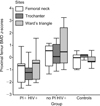Accelerated bone mineral loss in HIV-infected patients receiving potent antiretroviral therapy
- PMID: 10770534
- PMCID: PMC3170993
- DOI: 10.1097/00002030-200003100-00005
Accelerated bone mineral loss in HIV-infected patients receiving potent antiretroviral therapy
Abstract
Background: The use of highly active antiretroviral therapy (HAART) has been associated with multiple metabolic complications whose pathogenesis is poorly understood at the present time.
Methods: We performed a cross-sectional analysis of whole-body, lumbar spine (L1-L4) and proximal femur bone mineral density in 112 male subjects (HIV-infected patients on HAART that included a protease inhibitor, HIV-infected patients not receiving a protease inhibitor and healthy seronegative adults) using dual energy x-ray absorptiometry.
Results: Men receiving protease inhibitors had a higher incidence of osteopenia and osteoporosis according to World Health Organization definitions: relative risk = 2.19 (95% confidence interval 1.13-4.23) (P = 0.02). Subjects receiving protease inhibitors had greater central: appendicular adipose tissue ratios than the other two groups (P < 0.0001). There was no relationship between the central: appendicular fat ratio and the lumbar spine or proximal femur bone mineral density t- or z- scores, suggesting that osteoporosis and body fat redistribution are independent side effects of HAART.
Conclusions: Osteopenia and osteoporosis are unique metabolic complications associated with protease inhibitor-containing potent antiretroviral regimens, that appear to be independent of adipose tissue maldistribution.
Figures



Comment in
-
Response to 'Accelerated bone mineral loss in HIV-infected patients receiving potent antiretroviral therapy' by Drs Weil and Lenhard.AIDS. 2000 Oct 20;14(15):2417. doi: 10.1097/00002030-200010200-00031. AIDS. 2000. PMID: 11089638 No abstract available.
References
-
- Palella FJ, Jr, Delaney KM, Moorman AC, et al. Declining morbidity and mortality among patients with advanced human immunodeficiency virus infection. HIV Outpatient Study Investigators. N Engl J Med. 1998;338:853–860. - PubMed
-
- Anonymous. Update: trends in AIDS incidence – United States, 1996. MMWR. 1997;46:861–867. - PubMed
-
- Visnegarwala F, Krause KL, Musher DM. Severe diabetes associated with protease inhibitor therapy. Ann Intern Med. 1997;127:947. - PubMed
-
- Eastone JA, Decker CF. New-onset diabetes mellitus associated with use of protease inhibitor. Ann Intern Med. 1997;127:948. - PubMed
-
- Lo JC, Mulligan K, Tai VW, Algren H, Schambelan M. “Buffalo hump” in men with HIV-1 infection. Lancet. 1998;351:867–870. - PubMed
Publication types
MeSH terms
Substances
Grants and funding
LinkOut - more resources
Full Text Sources
Medical

